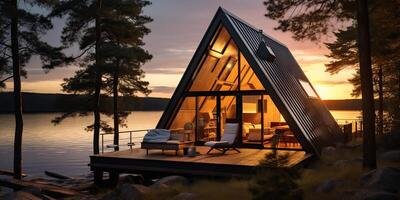Who Designed the Famous A-Frame House

The iconic A-frame house is one of the most recognizable architectural styles, celebrated for its triangular shape, steeply sloping roof, and timeless simplicity. While A-frame houses have existed in various forms across cultures for centuries, their modern popularity is often attributed to specific architects and designers who brought the style into the mainstream during the mid-20th century
The resurgence of the A-frame house as a modern architectural style is credited to mid-century architects and designers who adapted the form for leisure homes, vacation retreats, and affordable living. Two key figures stand out:
- Rudolph Schindler
- Austrian-American architect Rudolph Schindler is often credited with inspiring the A-frame’s modern revival. His design for the “Bennett House” in Lake Arrowhead, California, in 1934 is one of the earliest examples of a modern A-frame house. This structure featured a steeply pitched roof and minimalist interiors, setting the stage for the style’s future popularity.
- Andrew Geller
- Andrew Geller, an American architect, played a significant role in popularizing the A-frame house during the 1950s and 1960s. His iconic design for the “Elizabeth Reese House” in Long Island, New York, also known as the “Leisurama,” was featured in major publications like The New York Times. Geller’s designs combined functionality with whimsical elements, making A-frame houses synonymous with modern, relaxed living.
Several factors contributed to the A-frame’s rise to fame:
- Post-War Boom
- After World War II, there was a growing demand for affordable and easy-to-build housing. The A-frame’s simple construction and use of readily available materials made it an attractive option.
- Vacation Culture
- The mid-20th century saw a surge in second-home ownership. A-frame houses, often located in scenic mountain or lakeside areas, became the quintessential vacation retreat.
- Modernist Aesthetics
- The clean lines and geometric simplicity of the A-frame aligned with the modernist design principles of the time.
- Media and Marketing
- Architectural magazines, advertising campaigns, and popular culture helped cement the A-frame’s status as an aspirational design. Prefabricated A-frame kits also made the style accessible to DIY enthusiasts.
- Tags: home, housing, modern houses, modular construction, prefab, resorts, rocks
